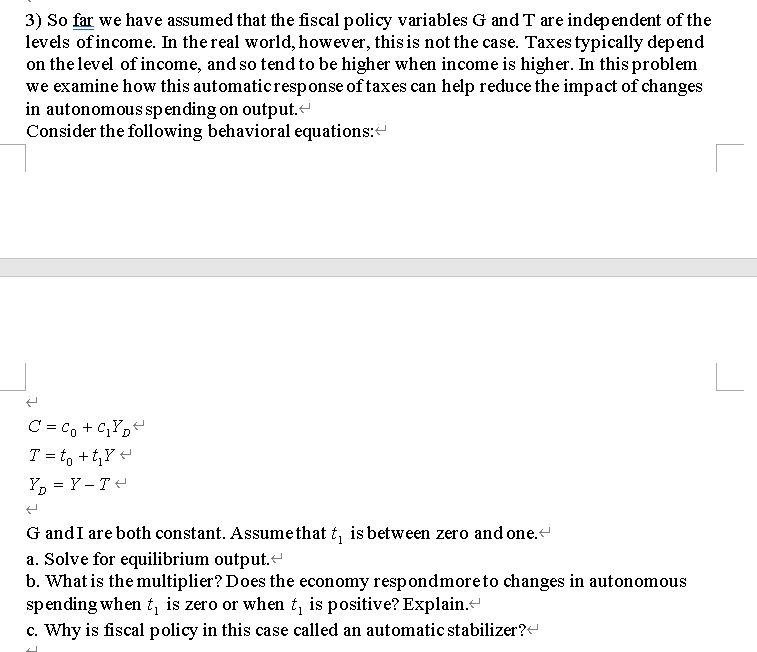3) So far we have assumed that the fiscal policy variables G and T are independent of the levels of income. In the real world, however, this is not the case. Taxes typically depend on the level of income, and so tend to be higher when income is higher. In this problem we examine how this automatic response of taxes can help reduce the impact of changes in autonomous spending on output. Consider the following behavioral equations: C=C₁+C₂YD+ T = t₁ +t₁Y+ YD=Y-T< e G and I are both constant. Assume that t₁ is between zero and one. a. Solve for equilibrium output. b. What is the multiplier? Does the economy respondmore to changes in autonomous spending when t, is zero or when t, is positive? Explain. c. Why is fiscal policy in this case called an automatic stabilizer?
3) So far we have assumed that the fiscal policy variables G and T are independent of the levels of income. In the real world, however, this is not the case. Taxes typically depend on the level of income, and so tend to be higher when income is higher. In this problem we examine how this automatic response of taxes can help reduce the impact of changes in autonomous spending on output. Consider the following behavioral equations: C=C₁+C₂YD+ T = t₁ +t₁Y+ YD=Y-T< e G and I are both constant. Assume that t₁ is between zero and one. a. Solve for equilibrium output. b. What is the multiplier? Does the economy respondmore to changes in autonomous spending when t, is zero or when t, is positive? Explain. c. Why is fiscal policy in this case called an automatic stabilizer?
Chapter24: Fiscal Policy
Section: Chapter Questions
Problem 5P
Related questions
Question

Transcribed Image Text:3) So far we have assumed that the fiscal policy variables G and T are independent of the
levels of income. In the real world, however, this is not the case. Taxes typically depend
on the level of income, and so tend to be higher when income is higher. In this problem
we examine how this automatic response of taxes can help reduce the impact of changes
in autonomous spending on output.
Consider the following behavioral equations:
C=C₁+C₂YD<
T = to +t₁Y+
Y₂ = Y-T<
G and I are both constant. Assume that t₁ is between zero and one.<
a. Solve for equilibrium output.
b. What is the multiplier? Does the economy respondmore to changes in autonomous
spending when t₁ is zero or when t₁ is positive? Explain.<
c. Why is fiscal policy in this case called an automatic stabilizer?
Expert Solution
This question has been solved!
Explore an expertly crafted, step-by-step solution for a thorough understanding of key concepts.
This is a popular solution!
Trending now
This is a popular solution!
Step by step
Solved in 3 steps with 1 images

Knowledge Booster
Learn more about
Need a deep-dive on the concept behind this application? Look no further. Learn more about this topic, economics and related others by exploring similar questions and additional content below.Recommended textbooks for you

Exploring Economics
Economics
ISBN:
9781544336329
Author:
Robert L. Sexton
Publisher:
SAGE Publications, Inc

Brief Principles of Macroeconomics (MindTap Cours…
Economics
ISBN:
9781337091985
Author:
N. Gregory Mankiw
Publisher:
Cengage Learning

Essentials of Economics (MindTap Course List)
Economics
ISBN:
9781337091992
Author:
N. Gregory Mankiw
Publisher:
Cengage Learning

Exploring Economics
Economics
ISBN:
9781544336329
Author:
Robert L. Sexton
Publisher:
SAGE Publications, Inc

Brief Principles of Macroeconomics (MindTap Cours…
Economics
ISBN:
9781337091985
Author:
N. Gregory Mankiw
Publisher:
Cengage Learning

Essentials of Economics (MindTap Course List)
Economics
ISBN:
9781337091992
Author:
N. Gregory Mankiw
Publisher:
Cengage Learning